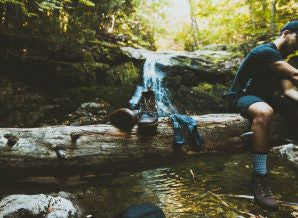8 Rules For Hiking In The Summer

Summer is the preferred time for hiking for the majority of hikers, not only because of the sun and warmth, but also because the daylight hours are longer. The summer season is usually vacation time and hikers can spend more time hiking and exploring old and new trails for longer. But when the temperatures start rising into the triple digits, most people prefer to stay at home safe and away from the scorching heat. There are ways though that you can continue enjoying hiking even when the temperatures are so high that you feel like crawling into your freezer instead.
Here are 8 basic rules for hiking in the summer, which if you follow closely will allow you to actually enjoy and survive hiking even in the hottest days of the year:
#1 Plan to start early in the morning Make sure you get up early enough so that you can enjoy your hiking trip as much as possible before the temps reach their peak, which is usually at noon to about 3 p.m. If this means getting up pre-dawn or at dawn, then you better do it in order to avoid the intensive heat and unbearable sun while on the trail before reaching to the elevation gain where temperatures will fall and become more enjoyable. Planning your trip is crucial, especially if you are hiking with kids. So, take the time to plan your wake-up time.
#2 Protect as much of your skin as possible from the sun It may sound strange, but wearing long sleeves and pants is much better for hiking in the summer. They will protect your skin from sunburn. Also, consider wearing a wide brimmed hat and UV protective sunglasses, to keep your face and eyes from the direct harmful sunlight. Remember that the sun is stronger as you gain elevation, so staying safe from the sun is crucial when hiking in the summer. Wear moisture wicking or wool fabrics to make sure that you sweat the heat off and that it dries quickly. Stay away from cotton clothes which will absorb the sweat and will become damp and heavy on you.
#3 Stay hydrated Intensive hiking in the summer can lead to the loss of nearly 2 liters (~68 ounces) of water from your body per hour, so make sure you have more than enough water when taking off. Rather than drinking a lot of water in longer time periods of hiking, remember to take regular small sips instead. This will help your body absorb the water better. Normally, the human body can absorb about half a liter (~17 ounces) of water per hour efficiently, so keep that in mind in order to stay hydrated.
#4 Don’t forget salt With rapid dehydration when hiking in the summer, your body needs to rebalance the proteins and electrolytes accordingly. Potassium and sodium are essential to help restore and maintain this balance and keep you well and healthy when hiking in the scorching heat. Make sure you pack sufficient quantities of complex carbs, GORP, trail mixes, electrolyte drinking mixes and some starchy fruits to keep your body functioning properly.
#5 Get sufficient rest Sit down in a shady place to enjoy that sip of water and a healthy snack occasionally. This will allow you to cool down a bit, the sweat to evaporate and your muscles to recover from the hiking.
#6 Pack some extra socks No matter how breathable your footwear is, chances are that your feet will sweat during an intensive hike in the heat. This can lead to discomfort, slipping and blistering which is the last thing you need when on the trail. Change your socks regularly and hang the damp ones on your backpack to dry before the next change.

#7 Make sure you know the symptoms of a heat stroke Even though you have taken all precautions to avoid it, it is essential that you learn to recognize the symptoms of heat stroke for yourself or your fellow hikers. Heat stroke if left untreated can be very dangerous and even fatal, especially when you are out in the wilderness and away from emergency help. Look for the initial signs of a possible heat stroke, such as: a strong headache, nausea and vomiting, dizziness and disorientation or confusion, cramping in the muscles or lack of sweat. These can be tell-tale signs that you or someone in your hiking group is suffering from a heat stroke. If you notice one or more of these symptoms it is crucial to get away from the sun, find shade and try to cool off the body. Begin planning how to get down as quickly as possible and call 911 if the symptoms are not going away or worsen.
#8 Choose the trail wisely and check the weather forecast before the hike The weather in the mountains can be unpredictable and can quickly switch from warm and sunny to a downpour. Make sure you check the forecast and ask the local rangers about the weather and the risks of unexpected storms. Also, when planning your summer hiking trip, choose a trail which is suitable for the season. Pick a trail which has sufficient shade, water and the appropriate elevation which will allow you to hike it safely and enjoyably even in the warmest days of the year.
About the author: Mike Pierce is an outdoor enthusiast, footwear fanatic, and coffee-lover. When he is not hiking, working or writing about work footwear, you can find him spending time with his family. He runs two websites dedicated to quality footwear – My Bootprint with special focus on work boots, and Shoe Matters – a site focused on comfortable footwear for different activities.


Comments on this post (0)